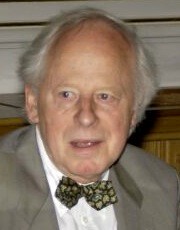 Gisbert Winnewisser
Gisbert Winnewisser
Gisbert Winnewisser
Contributed by Jürgen Stutzki and Richard Wielebinski
Gisbert Winnewisser was born on September 7th 1936 in the city of Karlsruhe, Germany. He died on March 21st 2015 after a long illness. After studying physics at the University of Karlsruhe he moved on for his PhD studies with Walter Gordy at Duke University in Durham, USA. He received his PhD degree in 1967 and continued for several years as a postdoc and Research Professor first at the Canadian National Research Council with Gerherd Herzberg and later at the University of British Columbia in Vancouver. He returned to Germany in 1972 and joined the Max-Planck-Institute for Radio Astronomy in Bonn. This was the era of the newly constructed 100m Effelsberg radio telescope with many possibilities of molecular spectroscopy research. In 1979 Gisbert Winnewisser was appointed full Professor at the Universität zu Köln. Here he started immediately to build up a molecular spectroscopy group. This included an instrumental project - the KOSMA-observatory (Kölner Observatorium für SubMillimeter Astronomie). Using a combination of the of large observatory instruments and KOSMA, Winnewisser's group became involved in numerous instrumentation projects: the HIFI/Herschel satellite project and the airborne observatory Sofia. One of the important contributions of the KOSMA observatory was the establishment of the Cologne Database of Molecular Spectroscopy.
The combination of molecular spectroscopy research and engineering developments led to many important results. Winnewisser was involved in the detection of such molecules as vinyl cyanide (C2H3CN), formic acid (HCOOH2) and methyl diacetylene (CH3CCCCH). The development of receivers and superconducting mixers were a hallmark of the institute. Acusto-optical spectrometers developed in Köln were used in numerous state of art projects, also in satellites.
The need to establish observing frequencies for new molecular species led Gisbert Winnewisser to organise a co-operation with his brother Manfred and sister-in-law Helga Winnewisser at the Justus Liebig University in Giessen. A molecular spectroscopy laboratory was built up and delivered the needed frequencies. It was a very fruitful cooperation.
Many other organisations benefited from Gisbert's experience and knowledge: he served on ESA's Scientific Advisory Board, and was a member of the advisory council of the Alexander von Humboldt Foundation, just to name two. He received the Honorary Medal of the University of Helsinki (1985) and the Max-Planck Research Prize (1993). His cooperation with the Charles University in Prague led to the awards of Ioannes Marcus Marci Society (1996) and the historical medal (1996). He was awarded the Bundesverdienstkreuz Erster Klasse, a high German recognition, in 2006.
The last years of Gisbert's life were shadowed by serious illness which limited his participation in active research. He did manage to participate in discussions with students and stimulate excitement for scientific research. Some 60 students obtained their PhD degrees as a result of his support. Many of his students have pursued distinguished scientific careers or have achieved recognition in other areas.
Modified on Monday, 14-Feb-2022 13:37:58 EST by Ellen Bouton, Archivist (Questions or feedback)
|
![[IAU logo]](iau_wb_thumb.jpg)
![[URSI logo]](URSI-logo-thumb.jpg)
![[Karl Jansky at his antenna]](jansky_photo_02_thumb.jpg)
![[Reber's Wheaton antenna]](Reber_Telescope_Wheaton_thumb.jpg)
![[Dover Heights]](Dover_Heights_02_thumb.jpg)
![[4C telescope]](GB61-195_4C_telescope_thumb.jpg)
![[Ewen and horn antenna]](ewen_horn1s.jpg)
![[Dwingeloo, 1956]](Dwingeloo-1956-thumb.jpg)
![[Jocelyn Bell Burnell and Cambridge antenna used in pulsar discovery]](burnell2_thumb.jpg)
![[Lovell Telescope at Jodrell Bank]](site_1594_0001-500-334-20180316163019-thumb150.jpg)
![[Wilson, Penzias, and Bell Labs horn antenna]](wilson-penzias-horn_thumb.jpg)
![[6-m Millimeter Radio Telescope in Mitaka, Japan]](6m-thumb.jpg)

